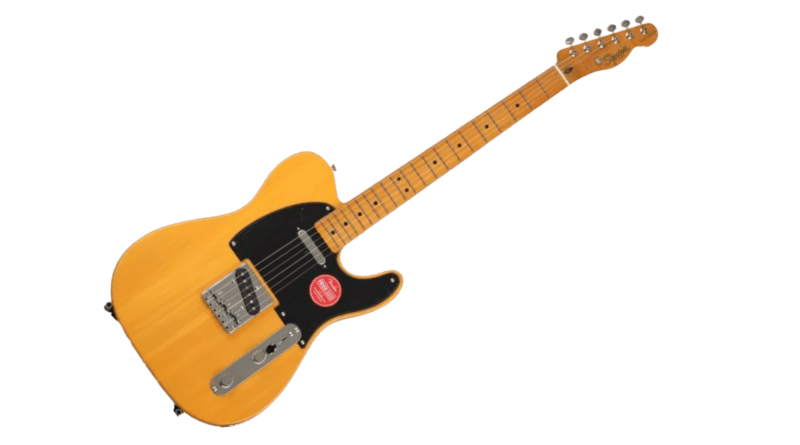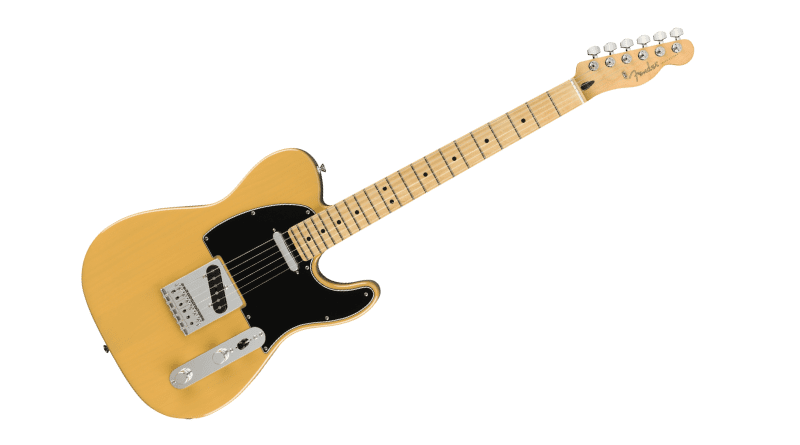Squier has been a perennial name in the starter instrument space for decades now, but those who know guitars know that they haven’t always been the most reliable choice.
Fortunately, Fender, and by proxy, Squier, have undergone something of a renaissance of late, and all signs point to a huge improvement across the board in terms of quality and playability, especially at the budget end of things.
In this KillerGuitarRigs Review, we got a chance to get hands on with the latest Squier Affinity Telecaster.
Has it improved over previous iterations? Keep reading as we find out.
Read more about our review process.
Contents
Who Is This For?
The Affinity Series Telecaster is very much aimed at beginners and those coming back to playing after a long absence. Price wise it’s an extremely affordable guitar, and it looks just like its much more expensive cousins produced under the Fender Brand.
This guitar, for not a lot of money, gets beginners into a real telecaster, complete with the signature feel and tones that you often don’t get with Telecaster copies, and to many, that alone is worth the price of entry.
Appearance / Features / Controls
This Squier Affinity Series Telecaster had all the classic looks and features that have kept this design a favorite since the 1950s. Our test model was in the new Olympic White finish, which we thought looked really sharp. It is available in a number of other colors, including solid and burst options, and of course, you can also get it in the classic Butterscotch Blonde.
Our test model was equipped with a maple neck and an Indian laurel fretboard. This was actually one of the best Indian Laurel fretboards we’ve played on any budget model. The pores weren’t too open, which gave it a nice, smooth feel. We do feel that this color would have looked better with the maple fretboard that comes with some of the other colors, but it’s not something that affected performance in any way.
It was equipped with a C shape neck profile, which we found to be pretty comfortable overall. We’d normally suggest a slim D profile for beginners, but this was a relatively slim C, which did help to promote good form in the fretting hand.
The die cast tuners were probably the weakest point of the guitar, hardware-wise. They look good, and the chrome finish is well applied, but the action tended to be a little jerky. Tuning stability was fine, but finding pitch often took longer than expected due to the lack of fine control.
Being a traditional Telecaster, it was equipped with a pair of single coil pickups, in this case Fender Ceramic Single Coils. We’ll go into more detail on how they sounded in the performance and sound section below.
The potentiometers fitted to the Affinity Tele are dime sized, and didn’t have the smoothest sweep, in fact, there was a pretty sharp drop off at around 4 on both volume and tone. Nevertheless, on board volume and tone isn’t usually something that beginners need a lot of control over while learning the fundamentals, so in the context of this guitar as a beginner’s instrument, they’re passable.
Performance/Sound
Affinity Telecasters, like most Squier models, are full scale, but not full thickness. This reduces the weight significantly, which is really a blessing when it comes to comfort. The body is made from poplar, which also adds to the lightness. Despite the reduced mass, we still found it to be nice and resonant, and even played acoustically, it was quite bright and surprisingly loud.
The resonance was definitely helped along by the synthetic bone nut, which was a nice touch compared to previous models which have shipped with a, frankly awful, plastic effort.
The action from the factory setup was a little higher than we usually like, but it was relatively easy to fix with a quick adjustment of the saddle height. Once we’d taken care of the action, we found it to be pretty smooth playing.
The radius was a little too tight for big bends, but the Telecaster has never really been a shredder’s guitar, anyway. As for chords, and more basic single note runs, we were able to make good fretboard contact without inducing much of any fret buzz, which was a big positive.
Something that has often plagued Affinity Series Telecasters in the past is fret sprout, and poorly finished fret edges. There’s no faster way to take the joy out of playing than with a lacerated finger! We’re happy to report, however, that the quality control seems to have improved significantly, and the frets were well finished with no protrusions.
We tested the Affinity Telecaster clean through a Fender Princeton Reverb profile in our Kemper, and we were actually quite impressed at the quality of the pickups. We’d played a Bullet Telecaster a couple of years ago and found that the neck pickup was so muddy it was barely useable, but in the case of the Affinity, the neck pickup had a nice warmth while still retaining clarity.
The bridge pickup is, of course, where the classic Telecaster twang comes from. If that’s a tone you’re looking for, you’ll find it in spades in this Affinity model. It was bright, spanky, and perfect for rock and country.
Other Guitars to Consider
If you’re thinking the Affinity Series Telecaster isn’t the guitar for you, there is a huge range of other options to check out, too:
Squier Classic Vibe ‘50s Telecaster

The Classic Vibe ‘50s Telecaster offers some of the most insane value for money you’ll find in the Entire Fender Family. If you’re looking for a full spec, high performance Tele, but funds are limited, the Classic Vibe will get you what you need. This is the flagship Squier Telecaster, and many consider it to be on par with the lower end Mexican made Fender models.
Fender Player Series Telecaster

If you’re working with a bigger budget and you’re looking to start out with a real Fender Telecaster, the entry level Fender Player Series Telecaster is a great place to start. It’s made to the same dimensions as US models, so many of the components are interchangeable, which makes it a fantastic modification platform, too. It sounds fantastic, looks great, and will last a lifetime.
Squier Classic Vibe ‘70s Telecaster Custom

If you’re into the Telecaster look, but you really want a bit more tonal variety, the Squier Classic Vibe ‘70s Custom is a superb option. It keeps the classic Telecaster twang with the single coil bridge pickup and 3 piece barrel saddles, but adds a warmer humbucking pickup in the neck position. This Tele plays beautifully, and the styling is absolutely fantastic.
Final Thoughts on the Squier Affinity Telecaster
While it isn’t the type of guitar that will grow with a player as their skills develop, the Squier Affinity Telecaster really does make a fantastic guitar for beginners.
It’s well made, offers some great tones, and with a basic setup it plays very nicely, not to mention the effortlessly cool styling that has made the Telecaster a rock and roll icon for almost 70 years!
If you’re looking for a great starter instrument from a reliable and well known brand, you can’t go far wrong with an Affinity Telecaster.
Check out these other articles you might like:


